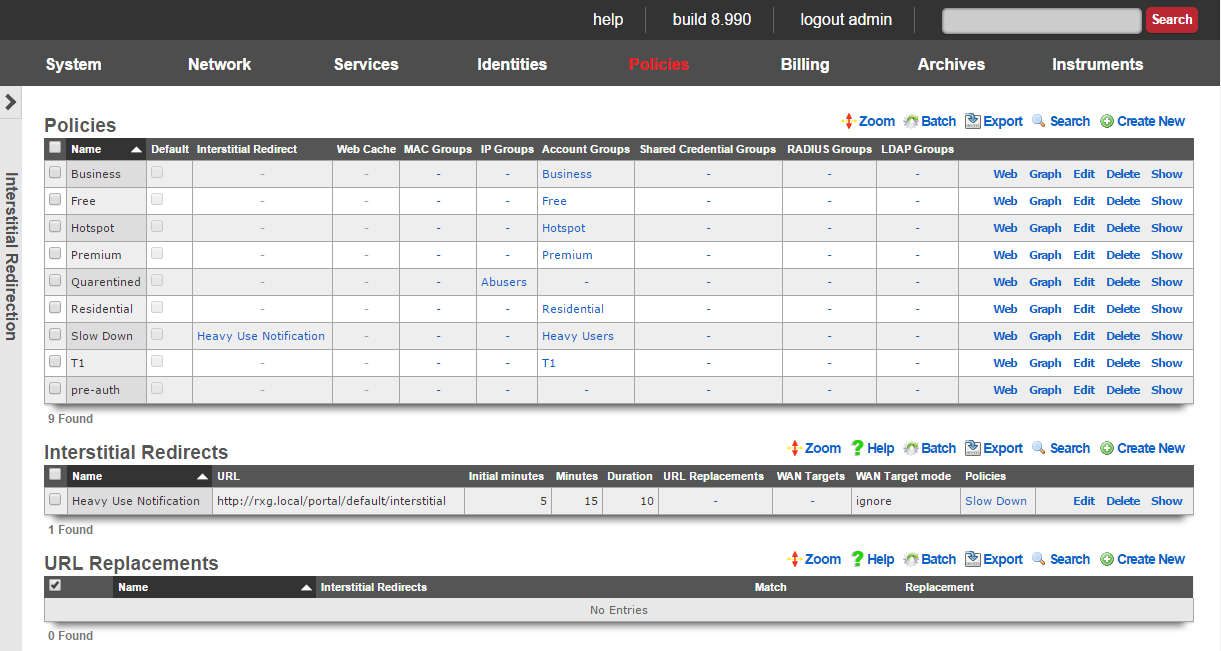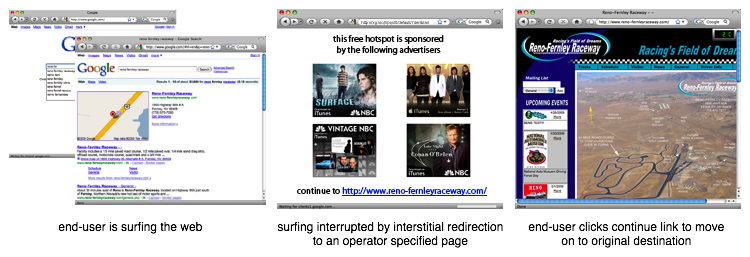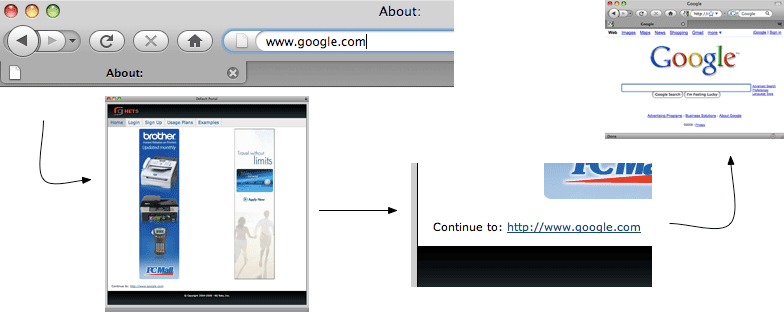Interstitial Redirection
Interstitial redirection is the periodic application of forced browser redirection to end-users for the purposes of generating impressions to an operator specified web page.

Interstitial redirection is a mechanism that enables operators to deploy advertising or other messaging on broadband networks in a manner that is similar to TV commercials. End-users and devices that been selected to take part in interstitial redirection are periodically redirected to a target of the operator's choosing. Furthermore, the rXg may require that the end-user experience the chosen target for a specified amount of time before they are able to continue on to their original destination.

Specific criteria must be met in order of a HTTP request to be redirected so that only "normal browsing" WWW sessions are interrupted. This enables web applications such as web-based email to continue to operate correctly even with interstitial redirection is enabled. In addition, interstitial redirection does not modify the content of transit pages in any way. The rXg goes to great lengths to ensure that interstitial redirection does not adversely affect the end-user in any way. 
In most cases, the interstitial redirection is a specialized view of the captive portal web application. This enables the operator to have complete control over the content. In a typical deployment, the interstitial view of the captive portal displays a "continue to original request" link as well as several rotated advertisements or other messages. The /interstitial view of the default portal is provided as an example of how an interstitial redirect target should be formatted.
The choice of content for the target of the interstitial redirects is entirely up to the operator. Any combination of static or dynamic images, JavaScript generated text or just about anything else imaginable can be placed on the redirection target. The most common application of interstitial redirection is to generate impressions of advertiser supplied videos. Forced viewing of video advertisements generate dramatically higher revenue per impression than image or text based advertisements (except for affiliate program conversions).

Interstitial Redirects
The interstitial redirects scaffold configures the periodic forced browser redirection of connected end-users to web content specified by the operator.
The name field is an arbitrary string descriptor used only for administrative identification. Choose a name that reflects the purpose of the record. This field has no bearing on the configuration or settings determined by this scaffold.
The initial minutes , minutes and duration fields control the timing behavior of the interstitial redirect mechanism. Using the broadcast television commercial analogy, the end-users experience a commercial that is duration seconds long with a periodicity specified by minutes. The initial minutes field specifies the amount of time before the first redirect. If the initial minutes is set to 0 then the end-user will experience redirect immediately upon login.
The URL field specifies the target for the forced browser redirect that occurs during an interstitial redirect. In most cases, the specified URL wll be a view of the onboard captive portal web application. The interstitial.erb in the default captive portal provides an example of an interstitial redirect target with advertising integration. An external web server may also be used as an interstitial redirection target.
Several substitution variables are available for dynamic URL assembly.
%url%The original URL that the browser requested when the interstitial redirection took affect. When the interstitial redirection workflow is complete, the end-user should be directed to this URL.%rxg%The domain name of the rXg as configured in Options view of the System menu.%ip%The IP address of the end-user device that has been subjected to the interstitial redirect.%mac%The MAC address of the end-user device that has been subjected to the interstitial redirect.%hostname%The DHCP client hostname of the end-user device that has been subjected to the interstitial redirect.%group%The effective group of the end-user when the interstitial redirect was initiated. %policy%The effective policy of the end-user when the interstitial redirect was initiated. %landing_portal%The landing portal associated with the effective policy of the end-user when the interstitial redirect was initiated. If no landing portal enforcement record exists, then the value of this variable will be 'default'.%portal_controller%The custom portal controller name associated with the effective policy of the end-user when the interstitial redirect was initiated. If no landing portal enforcement record exists, then the value of this variable will be 'default'.%random_number%A random eight digit integer.
An example of a URL that utilizes substitution variables is:
https://%rxg%/portal/%portal_controller%/interstitial?desired_url=%url%
The WAN targets field limits the effect of the interstitial redirect settings defined by this record to traffic that is originating from or destined to the IP addresses or DNS names listed in the selected WAN targets. By default, an interstitial redirect record affects all HTTP traffic matched by the policy regardless of WAN origin / destination. Setting a WAN target causes the breadth of the interstitial redirect to be limited to the specified hosts in the manner specified by the WAN target mode.
The WAN target mode field determines the effect of choosing WAN targets. When set to ignore, all HTTP requests originating from end-users and devices selected by the associated policy will take part in the interstitial redirect except for the requests that are headed to the IP addresses and DNS names in the chosen WAN targets.
The policy field relates this record to a set of groups through a policy record.
The note field is a place for the administrator to enter a comment. This field is purely informational and has no bearing on the configuration settings.

URL Replacements
The URL replacements scaffold enables fine grain configuration of the rXg HTTP URL request rewriting mechanism. URL replacements enable arbitrary modifications to the URL in an HTTP request. Thus an end-user retrieves a web page that is different from what they originally requested. The URL replacements mechanism uses the same underlying technology as the interstitial redirection feature. The key difference between the two is that the URL replacements mechanism allows for fine grain control. The interstitial redirection mechanism replaces the entire URL whereas the URL replacements mechanism only replaces a portion of the URL.
URL replacements must be associated with a interstitial redirection in order to function. The timing of the URL replacement is defined in the interstitial redirection. Only the first HTTP request in the periodicity defined in the interstitial redirection will be rewritten. All subsequent HTTP requests will pass unchanged.
The match and replacement fields configure the search and replace parameters used to rewrite the URL. For example if a match of microsoft is configured with a replacement of apple then an end-user HTTP request forwww.microsoft.com would be rewritten to www.apple.com. The match and replacement fields may also be used to modify the parameters passed in a HTTP GET. For example, a match of ?query=hello and a replacement of?query=goodbye would result in payload of the variablequery being changed from hello to goodbye. Thus an end-user that enters the string hello into an HTML form with an input of query that is submitted via a HTTP GET would end up being rewritten into submitting the stringgoodbye.